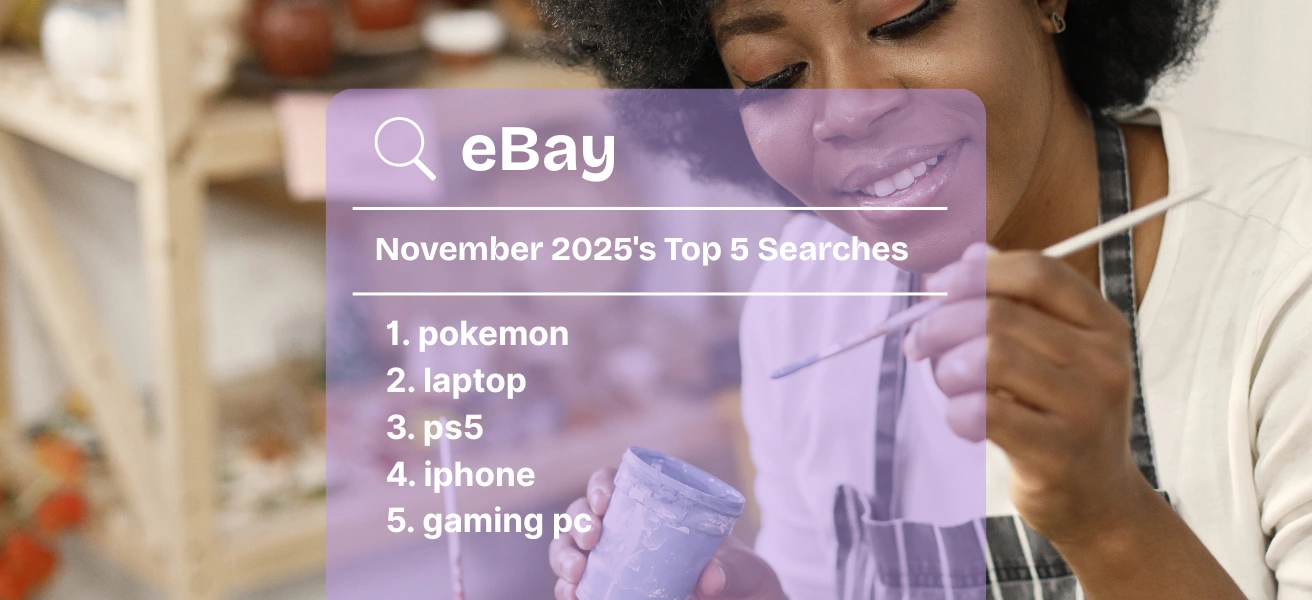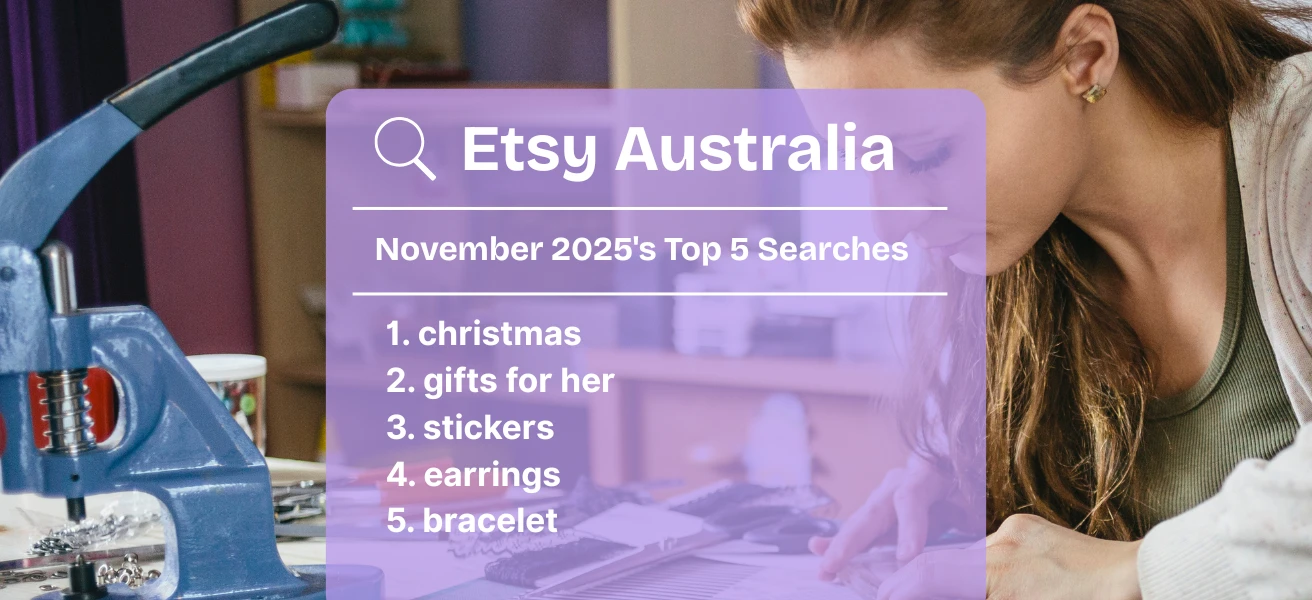Figuring out Etsy SEO is one of the hardest parts of running an Etsy business. Here, Starla Moore breaks down the process for you step-by-step so that you can start ranking in Etsy search. We have it in both video and article format.
Starla Moore is the founder of the Handmade Alpha Academy for Etsy sellers and a manager here at eRank.
“SEO” stands for Search Engine Optimization. On Etsy, “optimizing” means improving how your listings rank in relevant shoppers’ search results. To achieve it, your first step is keyword research. Because you need to find out whether shoppers search with the words you’ve got in your listings. And that requires a data-driven keyword tool.
Keyword research with a data-driven keyword tool
For this tutorial, I’ll be using eRank’s Keyword Tool. It’s on eRank’s Main Menu under Tools > Keyword Tool. Now, when doing keyword research, we want to “start broad and niche our way down.” For example, we’re selling a beige wool chunky knitted blanket. It’s better to begin with the broad keyword “blanket.” That lets Keyword Tool find more of those “niche” specific ideas we need.
Having entered our broad keyword, let’s spend some time at the top of the results page. Here, eRank displays several useful pieces of information. First, let’s look at the Keyword Statistics bar chart. Note that all metrics here are based on the past 12 months of Etsy data.
“Average Searches” shows the average monthly Etsy shopper searches for blanket. “Average Clicks” is the average monthly clicks that listings in searches for that keyword get. “Average CTR” (Click-Through Rate) is the ratio of clicks to searches, expressed as a percentage. “Etsy Seller Competition” indicates how much competition you can expect on Etsy search results pages.
As we see, all of these are really high. That’s because the keyword we entered is broad. So, we won’t worry about these high numbers; most broad searches have them.
Next, let’s scroll down the page to the Keyword Ideas table. This is where we’re going to find our golden nuggets. That is, good keyword possibilities to experiment with in our tags and titles.
Keyword Lists
Are you on any of eRank’s paid plans? If so, I recommend using the Keyword Lists feature here to save anything interesting. It makes keeping track of keywords and their data so much easier.
To save a keyword to one of your Keyword Lists, you just click the star next to the keyword. A pop-up will appear with a roster of your Keyword Lists. Select a list you’ve already started or create a new one for these keywords.
Then whenever you want to work with them, they’ll be ready. Best of all, the tool keeps their data continually updated for you.
Writing listing titles: low-hanging fruit
When choosing keywords, I recommend a combination of low-hanging fruits and one or two high-hanging fruits. By low-hanging fruit, I mean keywords that aren’t searched as much. They may not have the best click- and click-through rates. But their competition is lower, which means we can hopefully rank for these sooner.
Terms that could be low-hanging fruit:
-
knitted blanket
-
chunky knitted blanket
-
cozy blanket
As we’ve seen, our broad keyword “blanket” has far too much competition to rank for it in search. But perhaps we can rank for some of these more specific terms.
Attracting shoppers with exact matching
To optimize for Etsy’s search engine, there are two sides of the algorithm we want to appeal to. One side likes to see listing keywords be exactly as the shopper types them in. This is called exact matching. And strong keyword matching gives a powerful boost to your rank in search.
Example: shopper types “chunky knitted blanket” into Etsy’s search bar. For an exact match, we’d have “chunky knitted blanket” in order and intact in our titles and tags. I like to call these “superstar keywords” because they are the VIPs of our listings.
Choose your superstar keywords with care. First, they should be the search phrases you want most to be known for. And to rank highly for. Let’s say “chunky knitted blanket” describes exactly what you sell. Then next, you’d need to check the search-volume data. Are shoppers using this exact phrase to search? If so, then this would be a superstar keyword for you.
Optimizing with broad matches
The other side of the algorithm is a little less powerful, but still helps your listings to rank. It’s called broad matching. During its broad-matching process, Etsy will mix and match. That is, it puts together words which appear anywhere in your tags and titles.
In the keyword phrase “cozy beige chunky knitted blanket,” we exact-match for “chunky knitted blanket.” And we also broad-match for:
-
cozy blanket
-
beige blanket
-
beige knitted blanket
-
cozy knitted blanket
-
chunky blanket
-
beige chunky blanket
And more! Given Etsy’s broad-matching capabilities, it’s unnecessary to repeat the same words over and over in our title. Rather than “Beige Knitted Blanket, Chunky Knitted Blanket, Cozy Blanket,” we can have “Cozy Beige Chunky Knitted Blanket.” Because we will exact-match for our superstar keyword, chunky knitted blanket. And we’ll also broad-match for “cozy blanket, beige blanket, beige knitted blanket,” and so on.
Adding closely-related keywords to our title
Without the needless repetitions of “blanket,” our title now has lots of room for other keywords. Etsy allows up to 140 characters; we have 110 left! Ideally, you’d want to find terms closely related to your product that you could broad-match for. The term “wool blanket” is low-hanging fruit, so we’ll add “wool” to make our title “Cozy Beige Wool Chunky Knitted Blanket.”
Targeting shoppers
Etsy suggests having up to four keyword phrases in your title. But what if you’ve adequately described your item and can’t come up with another good descriptive phrase? In such cases, I recommend trying one related to your target customer. These typically won’t bring in a lot of traffic. But they are good to experiment with when you have room in your title.
For instance, we could complete our demo title by targeting buyers shopping for gifts for particular recipients. Let’s start by entering the broad search “gifts for” in Keyword Tool. It will generate a list of related suggestions for us.
From here, we’d scroll down to find “low-hanging fruit” keywords. At the time of this writing, “social worker gift” and “matron of honor gift” have okay search volume and competition levels. So, we’ll save them both to our Keyword List to keep an eye on.
Maybe we’ll test “matron of honor gift” in a different listing. We’ll see how its data holds up. For now, let’s add “social worker gift” to our title. It reads: “Beige Wool Chunky Knitted blanket, Cozy Gift for Social Worker.”
Selecting tags for your listings
Now that we’ve got our title, we next want to head down to our tags and begin filling these out. The tags section is another area that Etsy will use to make both exact-matches and broad-matches. Remember, exact matches are more powerful. Therefore, we’ll prioritize keeping our superstar keywords together where possible.
For instance, our superstar keyword “chunky knitted blanket” is 22 characters. Nuts, it’s too long to fit in a tag on its own. So, we’ll need to split it between two tags. We could either break it into “chunky knitted” or “knitted blanket.” A quick check in Keyword Tool tells us that no one is searching “chunky knitted” on its own. That means our best bet will be entering it as “knitted blanket.”
Next, we add “chunky wool,” “social worker gift,” and “cozy beige” to our tags. And having used all the words from our title, we see we’ve still got room in our tags to experiment with. Great! This is where to put keywords from our initial search that didn’t make the cut for our title. While they were too broad or competitive for our title, they are fine for finishing our tags.
Testing and experimenting
So, let’s go back to our original search for “blanket” in Keyword Tool. We saved:
-
throw blanket
-
soft blanket
-
handmade blankets
-
woven blanket
-
boho throw blanket
Let’s add some of these into our tags.
Now, you may be thinking, “Starla, didn’t you say we don’t need to repeat the word blanket because Etsy will broad match it?” And yes, this is true. But often, you’ll run out of keyword ideas before you fill all 13 tags. In such cases, it’s better to aim for an exact match. Rather than adding a one-word tag like “boho,” aim to rank for an exact match with “boho throw blanket.” This is all about testing and experimenting to see what works for you.
Publishing your listing
Once you’ve published your listing, be patient! It’s important to remember the following. Etsy’s algorithm can take 60 to 90 days to build a quality score for your listing. Every time you add a new listing, Etsy begins collecting data based on how shoppers interact with it. And after a period of 60 to 90 days, Etsy is able to decide where in search that listing should be ranked.
Therefore, do not edit this listing again during that 60 to 90-day window! Don’t interrupt Etsy as it assesses your listing quality. Give your listing plenty of time to climb.
Search trends
The last thing I want to show you is how to monitor your keywords so that you’ll know when search trends change. What’s popular this year may not be popular next year. Accordingly, you need to keep a close eye on the search volume of the keywords in your listings.
If you’re on one of eRank’s paid plans, you have the Keyword Lists feature mentioned earlier. For you, this process will be a lot quicker. But if you’re a free-plan member, you can manually enter the keywords from your listings to check their status. Since I have eRank Pro, I’m going to click here on the “Tools” tab and open my “Keyword Lists.”
From there, I can select which of my lists I want to review. I’ll choose my “blanket” list. And from there, at a glance I see the search volumes for my keywords in each one’s Trend Graph. One of my favorite things about eRank is that it updates this data continually. This way, when trends change, you’ll be the first to know – ideally, before your competitors do!
See these three? Their 15-mo Trend Graphs show me these aren’t being searched anymore. “Tweed blanket” appears to have been just a one-month fluke. Time to replace it with a shopper search that’s trending now.
SEO: the map that leads customers to your listings
We’ve covered how keywords optimize your listings for search engines. And that process is a necessary, powerful factor determining rank (that is, being found) on Etsy. But keywords are just one element in Etsy’s search algorithm.
To grow your shop on Etsy, you’ll need other ranking factors working for you as well. Among the strongest signals Etsy gets come from your sales and reviews. Together, these tell Etsy whether it’s profitable and safe to recommend your products to more shoppers.
Using data-driven tools for keywords and help from an expert seller, you’ll be well on your way to Etsy success.
You can follow Starla Moore on YouTube here: @starlamoore
















